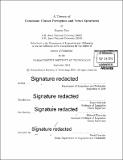| dc.contributor.advisor | Donca Steriade and Edward Flemming. | en_US |
| dc.contributor.author | Yun, Suyeon, Ph. D. Massachusetts Institute of Technology | en_US |
| dc.contributor.other | Massachusetts Institute of Technology. Department of Linguistics and Philosophy. | en_US |
| dc.date.accessioned | 2017-02-22T19:03:04Z | |
| dc.date.available | 2017-02-22T19:03:04Z | |
| dc.date.copyright | 2016 | en_US |
| dc.date.issued | 2016 | en_US |
| dc.identifier.uri | http://hdl.handle.net/1721.1/107089 | |
| dc.description | Thesis: Ph. D., Massachusetts Institute of Technology, Department of Linguistics and Philosophy, 2016. | en_US |
| dc.description | Cataloged from PDF version of thesis. | en_US |
| dc.description | Includes bibliographical references (pages 149-154). | en_US |
| dc.description.abstract | This dissertation concerns cluster-dependent asymmetries in vowel epenthesis in loanword adaptation and in non-native cluster perception. The central argument is that auditory factors affect the relative perceptual similarity between consonant clusters and the corresponding epenthesis forms, which in turn plays an important role in determining the site of epenthesis in loanword adaptation. This dissertation provides an extended typology of vowel epenthesis sites in consonant cluster adaptation, considering a variety of clusters both in word-initial and in word-final positions. It will be argued that the cluster-dependent asymmetries in epenthesis sites are best explained by the auditory properties of consonant clusters, such as intensity rise. Specifically, if a cluster involves an intensity rise inside the cluster, epenthesis occurs inside the cluster; if a cluster involves an intensity rise outside the cluster, epenthesis occurs outside the cluster; and if a cluster involves two intensity rises, either internal or external epenthesis can occur. I argue that this is because the epenthetic vowel insertion where there is an intensity rise makes a perceptually less salient change from the original cluster than epenthesis where there is no intensity rise, based on the P-map hypothesis (Steriade, 2008) that an output involving a perceptually smaller change is more optimal. The results of several perception experiments support the hypothesis by showing that not only intensity rise but also C1 voicing have a significant effect on the perceptual similarity between the consonant clusters and the corresponding epenthesis forms. Crucially, it will be shown that the novel generalization about vowel epenthesis sites and the results of perception experiments employing phonetically diverse stimuli can be best explained by the auditory properties, and not by the sonority profile, which has traditionally been used to explain these data. | en_US |
| dc.description.statementofresponsibility | by Suyeon Yun. | en_US |
| dc.format.extent | 154 pages | en_US |
| dc.language.iso | eng | en_US |
| dc.publisher | Massachusetts Institute of Technology | en_US |
| dc.rights | MIT theses are protected by copyright. They may be viewed, downloaded, or printed from this source but further reproduction or distribution in any format is prohibited without written permission. | en_US |
| dc.rights.uri | http://dspace.mit.edu/handle/1721.1/7582 | en_US |
| dc.subject | Linguistics and Philosophy. | en_US |
| dc.title | A theory of consonant cluster perception and vowel epenthesis | en_US |
| dc.type | Thesis | en_US |
| dc.description.degree | Ph. D. | en_US |
| dc.contributor.department | Massachusetts Institute of Technology. Department of Linguistics and Philosophy | |
| dc.identifier.oclc | 971249516 | en_US |
